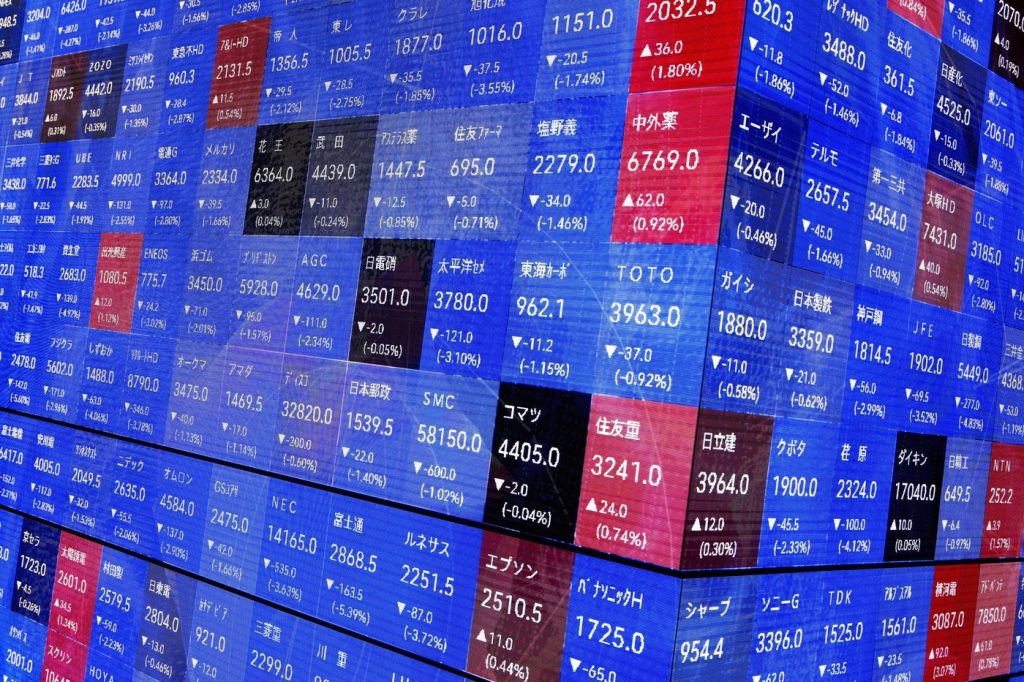TOKYO (AP) - Asian shares displayed a mixed performance on Wednesday as investors analyzed the ramifications of President Donald Trump’s latest tariffs following another day of declines on Wall Street. U.S. futures and oil prices showed signs of recovery, with Trump’s tariff escalation affecting market sentiment significantly.
The U.S. trade war's intensification momentarily pushed the S&P 500 over 10% below its record set the previous month. This market volatility came after Trump increased tariffs against Canadian steel and aluminum, leading Ontario, a Canadian province, to remove a contentious surcharge that had drawn Trump's ire. In Japan, the benchmark Nikkei 225 saw a slight uptick of 0.2%, reaching 36,880.79 in morning trading.
In the Hong Kong market, the Hang Seng index increased by 0.3% to 23,845.37, while the Shanghai Composite fell by nearly 0.1% to 3,377.95. Conversely, Australia’s S&P/ASX 200 fell by 1.7% to 7,756.90, whereas South Korea’s Kospi index experienced a gain of 1.5%, ending at 2,575.39. On Wall Street, the S&P 500 experienced a decline of 0.8%, closing at a level 9.3% below its all-time high. The Dow Jones Industrial Average tumbled by 1.1% to 41,433.48. The Nasdaq composite also faced a slight decrease, slipping by 0.2% to 17,436.10. Analysts noted that the sharp stock market fluctuations were becoming commonplace as Trump navigates his ambitions to reshape the U.S. and global economies through tariffs and related policies.
Tim Waterer, chief market analyst at KCM Trade, commented on the destabilizing effects brought about by Trump’s tariff policies, stating, "Investors are left guessing as to which measures will either be added or walked back next." The unpredictability surrounding these tariffs has sown confusion and pessimism among U.S. households and businesses.
Trump has acknowledged that his tariff policies could inflict some “disturbance” on the economy. During a recent press briefing, White House press secretary Karoline Leavitt refrained from providing a concrete answer on how much economic pain Trump would tolerate, but assured that he would prioritize both Wall Street and Main Street. In a notable statement on social media, Trump suggested that it would make sense for Canada to be incorporated as the United States’ “Fifty First State,” asserting that this would eliminate all tariffs and related issues.
After Ontario's premier announced the removal of the electricity surcharge that upset Trump, stocks briefly regained lost ground. However, Trump later indicated that he would "probably" reimpose the 25% tariffs on Canadian steel and aluminum. The day’s trading volatility followed various warning signals about the economy, including those stemming from Trump’s fluctuating tariffs strategy, which is causing anxiety among consumers and business sectors.
The direct repercussions of such tariffs could lead to increased consumer prices in the U.S. and muddy global trade dynamics. Even if the actual tariff impacts turn out to be less severe than anticipated, the erratic market movements could deter U.S. companies and consumers from making investments or expenditures. Interestingly, several prominent tech stocks began to stabilize after facing significant downturns recently. Tesla, led by Elon Musk, rose by 3.8% following Trump’s declaration of intent to purchase a Tesla vehicle. Other major tech stocks like Nvidia also showed resilience, adding 1.7% and reducing its year-to-date losses to 19% amidst a broader market sell-off.
A report released on Tuesday indicated that U.S. employers were posting 7.7 million job openings by the end of January, matching economist expectations and signaling that the job market remains solid, at least for the time being. In energy markets, benchmark U.S. crude rose by 52 cents to $66.77 a barrel, while the international standard, Brent crude, climbed by 51 cents to $70.07 a barrel.
In currency trading, the U.S. dollar appreciated against the Japanese yen, climbing to 148.22 from 147.78 yen, while the euro saw a slight dip, costing $1.0902 down from $1.0919.










